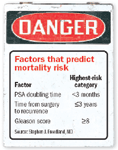Article
Three factors predict death from recurring prostate cancer
Baltimore--Researchers at the Brady Urological Institute at Johns Hopkins have identified three risk factors that help determine whether a patient's risk of death from recurrent prostate cancer is high or low following surgery. This insight will help urologists to better determine whether aggressive or conservative treatment is best for many patients, according to the authors of the study, published in JAMA (2005; 294:433-9).

Urologists have long known that, while some men whose prostate cancer reoccurs after radical prostatectomy have slow-growing tumors, others have a rapid clinical course. Co-authors Stephen J. Freedland, MD, and Alan Partin, MD, PhD, of Johns Hopkins University, Baltimore, looked at factors that would separate those with the fast-growing tumors from those who do not.
Researchers looked at 379 men who were treated with radical prostatectomy at Johns Hopkins between 1982 and 2000 and who had PSA recurrences.

According to Dr. Freedland, one noteworthy aspect of the data was that the majority of patients were treated by Patrick Walsh, MD, professor of urology and former chairman of the department.
"To a large degree, it is Dr. Walsh's personal series," Dr. Freedland said. "Dr. Walsh's belief has always been that we should wait until the men have metastases before starting hormonal therapy, so it allowed us to examine the natural history of the disease. It was a unique opportunity to assess the biology of the cancer."
Predicting mortality risk
Researchers identified three factors that helped predict those men who would have rapidly progressing cancers and increased risk of death from prostate cancer, as well as those who probably would be alive in 15 years.
The first factor is the time for PSA to double after surgery, or PSA doubling time. The faster the PSA doubled, the more likely the men were to progress. The highest-risk category was a PSA doubling time of less than 3 months, followed by a doubling time within 3 to 9 months. The risk was low when the PSA doubled within 9 to 15 months, and lowest at more than 15 months.
The second factor was how quickly the PSA became detectable after surgery.
"The quicker it was detectable (for us, that was 0.2 ng/mL or greater), the higher the risk," Dr. Freedland said. "If the PSA was detectable in 3 years, it was a bad sign, and if it was detectable after 3 years, that was lower risk."
The third factor, the Gleason score, indicated that surgical specimens scoring 8 or above signaled a high risk; scores 7 or below meant a lower risk.
"We looked at those factors and how they would predict time to death. We were able to then take that and create tables to assess the risk of death," Dr. Freedland said. "What is amazing to me is that you can take a man who has all the low-risk features-a man whose doubling time is greater than 15 months, a Gleason score below 7, recurrence after 3 years-and 15 years later-and the estimated survival was 94%. If you take a man in the worst group-doubling time less than 3 months, recurrence within 3 years, and Gleason score 8 or higher-our estimate was [that] less than 1% of those men would be alive after 15 years."
Newsletter
Stay current with the latest urology news and practice-changing insights — sign up now for the essential updates every urologist needs.
















